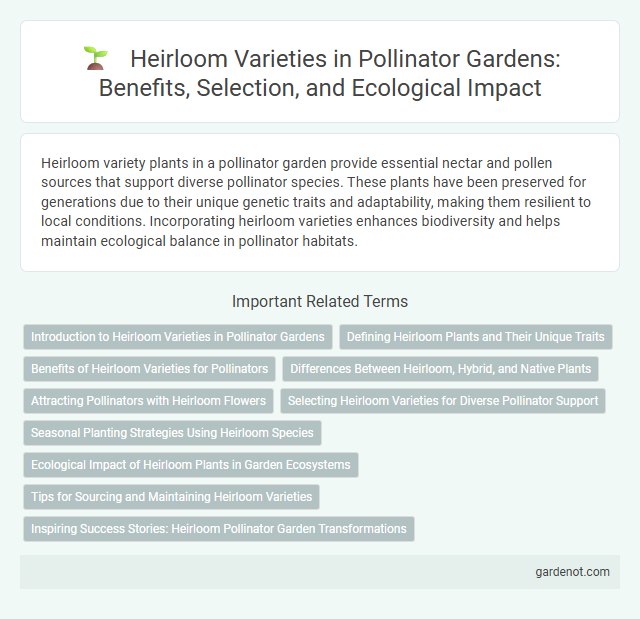Heirloom variety plants in a pollinator garden provide essential nectar and pollen sources that support diverse pollinator species. These plants have been preserved for generations due to their unique genetic traits and adaptability, making them resilient to local conditions. Incorporating heirloom varieties enhances biodiversity and helps maintain ecological balance in pollinator habitats.
Introduction to Heirloom Varieties in Pollinator Gardens
Heirloom varieties are traditional plant species that have been preserved through generations, offering rich genetic diversity crucial for pollinator health. These plants provide unique nectar and pollen sources that attract a wide range of pollinators, including native bees, butterflies, and hummingbirds. Incorporating heirloom flowers, vegetables, and herbs in pollinator gardens supports ecosystem resilience and sustains declining pollinator populations.
Defining Heirloom Plants and Their Unique Traits
Heirloom plants are open-pollinated varieties that have been carefully preserved and passed down through generations, often prized for their genetic diversity and rich flavors. These plants exhibit unique traits such as exceptional resilience, distinctive colors, and varied shapes that support biodiversity in pollinator gardens. Cultivating heirloom varieties enhances pollinator habitats by providing diverse nectar sources crucial for bees, butterflies, and other pollinating insects.
Benefits of Heirloom Varieties for Pollinators
Heirloom varieties offer diverse floral structures and nectar profiles that attract a wide range of pollinators, including native bees, butterflies, and hummingbirds. Their genetic stability ensures consistent bloom times and reliable pollen availability, enhancing habitat sustainability for pollinator populations. By supporting heirloom plants, gardeners promote biodiversity and strengthen ecosystem resilience, benefiting pollinator health and productivity.
Differences Between Heirloom, Hybrid, and Native Plants
Heirloom plants are open-pollinated varieties preserved for their genetic purity and traditional traits, contrasting with hybrids that result from controlled cross-breeding for specific characteristics. Unlike native plants, which have evolved naturally in a region and provide essential habitat for local pollinators, heirloom varieties often carry unique flavors and appearances but may lack the adaptability of native species. Selecting a mix of heirloom, hybrid, and native plants in a pollinator garden promotes biodiversity, resilience, and supports a broad range of pollinators.
Attracting Pollinators with Heirloom Flowers
Heirloom flowers, known for their rich genetic diversity and vibrant colors, play a crucial role in attracting a wide range of pollinators such as bees, butterflies, and hummingbirds. These flowers produce abundant nectar and pollen, making them highly attractive to native pollinator species essential for ecosystem health. Incorporating heirloom varieties in a pollinator garden enhances biodiversity and supports the lifecycle of pollinators by providing continuous bloom cycles and natural habitat.
Selecting Heirloom Varieties for Diverse Pollinator Support
Selecting heirloom varieties for pollinator gardens enhances biodiversity by providing a range of floral resources that attract native bees, butterflies, and hummingbirds. Heirloom plants often have unique nectar and pollen profiles that support specialized pollinators, promoting ecosystem resilience. Incorporating diverse heirloom species ensures continuous bloom periods, meeting the nutritional needs of multiple pollinator species throughout the growing season.
Seasonal Planting Strategies Using Heirloom Species
Heirloom varieties in pollinator gardens enhance seasonal planting strategies by providing diverse floral resources that bloom sequentially throughout the year, ensuring continuous nectar and pollen availability for pollinators. These traditional, open-pollinated species adapt well to local climates and exhibit genetic diversity, increasing resilience against pests and diseases while supporting native pollinator populations. Integrating heirloom plants like Echinacea purpurea and Monarda fistulosa into planting schedules maximizes habitat value and sustains pollinator activity across spring, summer, and fall seasons.
Ecological Impact of Heirloom Plants in Garden Ecosystems
Heirloom plant varieties enhance garden ecosystems by supporting diverse pollinator populations, promoting genetic biodiversity, and maintaining resilient habitats. Their adaptation to local environments fosters ecological balance, benefiting native bees, butterflies, and other essential pollinators. Incorporating heirloom plants in a pollinator garden strengthens ecosystem services such as pollination, soil health, and natural pest control.
Tips for Sourcing and Maintaining Heirloom Varieties
Heirloom varieties in pollinator gardens offer genetic diversity and unique floral traits that attract a wide range of pollinators. Source seeds from reputable heirloom seed banks and local nurseries specializing in native plants to ensure authenticity and adaptability to your region. Maintain these varieties through proper soil preparation, regular watering, and rotating crops to preserve their resilience and support thriving pollinator populations.
Inspiring Success Stories: Heirloom Pollinator Garden Transformations
Heirloom pollinator gardens showcase remarkable success stories where rare, open-pollinated plant varieties have revitalized local ecosystems by attracting diverse pollinator species such as native bees, butterflies, and hummingbirds. These carefully preserved heirloom plants not only enhance biodiversity but also improve pollination efficiency, leading to healthier gardens and increased yields in nearby crops. Enthusiasts report significant ecological restoration and community engagement by cultivating heirloom varieties, demonstrating the powerful impact of preserving genetic heritage in pollinator habitats.
Heirloom variety Infographic

 gardenot.com
gardenot.com